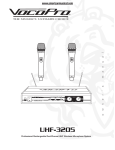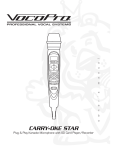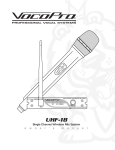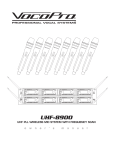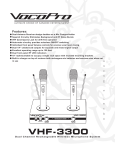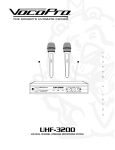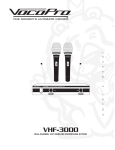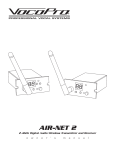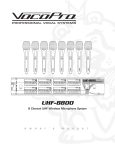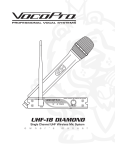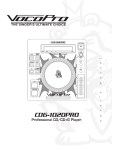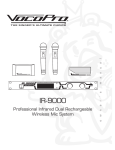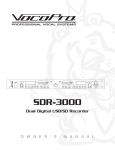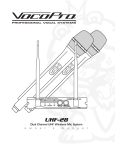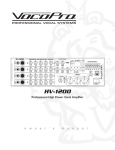Download VocoPro VHF-3308 Operating instructions
Transcript
BATT LOW BATT LOW ON ON OFF OFF CH B CH A VHF-3308 o w DUAL CHANNEL RECHARGEABLE WIRELESS MICROPHONE SYSTEM n e r ' s m a n u a l Table of Contents Safety Instructions . . . . . . . FCC Information . . . . . . . . . Welcome . . . . . . . . . . . . . Listening for a Lifetime . . . . Features . . . . . . . . . . . . . Before Getting Started . . . . Getting Connected . . . . . . . Descriptions and Functions . Microphone Basics . . . . . . Operations . . . . . . . . . . . . Troubleshooting . . . . . . . . . . . . . . . . . . . . . . . . . . . . . . . . . . . . . . . . . . . . . . . . . . . . . . . . . . . . . . . . . . . . . . . . . . . . . . . . . . . . . . . 4 . 5 . 6 . 7 . 8 . 9 10 11 13 15 16 Safety Instructions 8. Ventilation - The appliance should be situated so its location does not interfere with its proper ventilation. For example, the appliance should not be situated on a bed, sofa, rug, or similar surface that may block the ventilation slots. CAUTION RISK OF SHOCK CAUTION: To reduce the risk of electric shock, do not remove cover (or back). No user-serviceable parts inside. Only refer servicing to qualified service personnel. 9. Heat - The appliance should be situated away from heat sources such as radiators, heat registers, stoves, or other appliances (including amplifiers) that produce heat. 10. Power Sources - The appliance should be connected to a power supply only of the type described in the operating instructions or as marked on the appliance. Explanation of Graphical Symbols The lightning flash & arrowhead symbol, within an equilateral triangle, is intended to alert you to the presence of danger. 11. Grounding or Polarization - Precautions should be taken so that the grounding or polarization means of an appliance is not defeated. 12. Power-Cord Protection - Power-supply cords should be routed so that they are not likely to be walked on or pinched by items placed upon or against them, paying particular attention to cords at plugs, convenience receptacles, and the point where they exit from the appliance. The exclamation point within an equilateral triangle is intended to alert you to the presence of important operating and servicing instructions. WARNING 13. Cleaning - Unplug this unit from the wall outlet before cleaning. Do not use liquid cleaners or aerosol cleaners. Use a damp cloth for cleaning. To reduce the risk of fire or electric shock, do not expose this unit to rain or moisture. 14. Power lines - An outdoor antenna should be located away from power lines. 1. Read Instructions - All the safety and operating instructions should be read before the appliance is operated. 15. Nonuse Periods - The power cord of the appliance should be unplugged from the outlet when left unused for a long period of time. 2. Retain Instructions - The safety and operating instructions should be retained for future reference. 16. Object and Liquid Entry - Care should be taken so that objects do not fall and liquids are not spilled into the enclosure through openings. 3. Heed Warnings - All warnings on the appliance and in the operating instructions should be adhered to. 17. Damage Requiring Service - The appliance should be serviced by qualified service personnel when: 4. Follow Instructions - All operating and use instructions should be followed. A. B. C. D. The power supply cord or plug has been damaged; or Objects have fallen into the appliance; or The appliance has been exposed to rain; or The appliance does not appear to operate normally or exhibits a marked change in performance; or E. The appliance has been dropped, or the enclosure damaged. 5. Attachments - Do not use attachments not recommended by the product manufacturer as they may cause hazards. 6. Water and Moisture - Do not use this unit near water. For example, near a bathtub or in a wet basement and the like. 18. Servicing - The user should not attempt to service the appliance beyond that described in the operating instructions. All other servicing should be referred to qualified service personnel. 7. Carts and Stands - The appliance should be used only with a cart or stand that is recommended by the manufacturer. Note: To CATV system installer's (U.S.A.): This reminder is provided to call the CATV system installer's attention to Article 820-40 of the NEC that provides guidelines for proper grounding and, in particular, specifies that the cable ground shall be connected as close to the point of cable entry as practical. 7 A. An appliance and cart combination should be moved with care. Quick stops, excessive force, and uneven surfaces may cause an overturn. 4 FCC Information 1. IMPORTANT NOTICE: DO NOT MODIFY THIS UNIT!: This product, when installed as indicated in the instructions contained in this manual, meets FCC requirements. Modifications not expressly approved by Vocopro may void your authority, granted by the FCC, to use this product. 2. IMPORTANT: When connecting this product to accessories and/or another product use only high quality shielded cables. Cable(s) supplied with this product MUST be used. Follow all installation instructions. Failure to follow instructions could void your FCC authorization to use this product in the U.S.A. 3. NOTE: This product has been tested and found to comply with the requirements listed in FCC Regulations, Part 15 for Class "B" digital devices. Compliance with these requirements provides a reasonable level of assurances that your use of this product in a residential environment will not result in harmful interference with other electronic devices. This equipment generates/uses radio frequencies and, if not installed and used according to the instructions found in the owner's manual, may cause interference harmful to the operation of other electronic devices. Compliance with FCC regulations does not guarantee that interference will not occur in all installations. If this product is found to be the source of interference, which can be determined by turning the unit "Off" and "On", please try to eliminate the problem by using one of the following measures: Relocate either this product or the device that is being affected by the interference. Use power outlets that are on different branch (circuit breaker or fuse) circuits or install AC line filter(s). In the case of radio or TV interference, relocate/reorient the antenna. If the antenna lead-in is 300-ohm ribbon lead, change the lead-in to coaxial type cable. If these corrective measures do not produce satisfactory results, please contact your local retailer authorized to distribute Vocopro products. If you can not locate the appropriate retailer, please contact Vocopro, 1728 Curtiss Court, La Verne, CA 91750. CAUTION The apparatus is not disconnected from the AC power source so long as it is connected to the wall outlet, even if the apparatus itself is turned off. To fully ensure that the apparatus is indeed fully void of residual power, leave unit disconnected from the AC outlet for at least fifteen seconds. CAUTION: READ THIS BEFORE OPERATING YOUR UNIT 1. To ensure the finest performance, please read this manual carefully. Keep it in a safe place for future reference. 2. Install your unit in a cool, dry, clean place - away from windows, heat sources, and too much vibration, dust, moisture or cold. Avoid sources of hum (transformers, v motors). To prevent fire or electrical shock, do not expose to rain and water. 3. Do not operate the unit upside-down. 4. Never open the cabinet. If a foreign object drops into the set, contact your dealer. 5. Place the unit in a location with adequate air circulation. Do not interfere with its proper ventilation; this will cause the internal temperature to rise and may result in a failure. 6. Do not use force on switches, knobs or cords. When moving the unit, first turn the unit off. Then gently disconnect the power plug and the cords connecting to other equipment. Never pull the cord itself. 7. Do not attempt to clean the unit with chemical solvents: this might damage the finish. Use a clean, dry cloth. 8. Be sure to read the "Troubleshooting" section on common operating errors before concluding that your unit is faulty. 9. This unit consumes a fair amount of power even when the power switch is turned off. We recommend that you unplug the power cord from the wall outlet if the unit is not going to be used for a long time. This will save electricity and help prevent fire hazards. To disconnect the cord, pull it out by grasping the plug. Never pull the cord itself. 10. To prevent lightning damage, pull out the power cord and remove the antenna cable during an electrical storm. 11. The general digital signals may interfere with other equipment such as tuners or receivers. Move the system farther away from such equipment if interference is observed. NOTE: Please check the copyright laws in your country before recording from records, compact discs, radio, etc. Recording of copyrighted material may infringe copyright laws. Voltage Selector (General Model Only) Be sure to position the voltage selector to match the voltage of your local power lines before installing the unit. 110V 5 Welcome And thank you for purchasing the VHF-3308 from VocoPro, your ultimate choice in Karaoke entertainment! With years of experience in the music entertainment business, VocoPro is a leading manufacturer of Karaoke equipment, and has been providing patrons of bars, churches, schools, clubs and individual consumers the opportunity to sound like a star with full-scale club models, in-home systems and mobile units. All our products offer solid performance and sound reliability, and to reinforce our commitment to customer satisfaction, we have customer service and technical support professionals ready to assist you with your needs. We have provided some contact information for you below. VocoPro 1728 Curtiss Court La Verne, CA 91750 Toll Free: 800-678-5348 TEL: 909-593-8893 FAX: 909-593-8890 VocoPro Company Email Directory Customer Service & General Information [email protected] Tech Support [email protected] Remember Our Website Be sure to visit the VocoPro website www.vocopro.com for the latest information on new products, packages and promos. And while you're there don't forget to check out our Club VocoPro for Karaoke news and events, chat rooms, club directories and even a KJ Service directory! We look forward to hearing you sound like a PRO, with VocoPro, the singer’s ultimate choice. FOR YOUR RECORDS Please record the model number and serial number below, for easy reference, in case of loss or theft. These numbers are located on the rear panel of the unit. Space is also provided for other relevant information Model Number Serial Number Date of Purchase 6 Listening for a Lifetime Selecting fine audio equipment such as the unit youʼve just purchased is only the start of your musical enjoyment. Now itʼs time to consider how you can maximize the fun and excitement your equipment offers. VocoPro and the Electronic Industries Associationʼs Consumer Electronics Group want you to get the most out of your equipment by playing it at a safe level. One that lets the sound come through loud and clear without annoying blaring or distortion and, most importantly, without affecting your sensitive hearing. Sound can be deceiving. Over time your hearing “comfort level” adapts to a higher volume of sound. So what sounds “normal” can actually be loud and harmful to your hearing. Guard against this by setting your equipment at a safe level BEFORE your hearing adapts. To establish a safe level: • Start your volume control at a low setting. • Slowly increase the sound until you can hear it comfortably and clearly, and without distortion. Once you have established a comfortable sound level: • Set the dial and leave it there. • Pay attention to the different levels in various recordings. Taking a minute to do this now will help to prevent hearing damage or loss in the future. After all, we want you listening for a lifetime. Used wisely, your new sound equipment will provide a lifetime of fun and enjoyment. Since hearing damage from loud noise is often undetectable until it is too late, this manufacturer and the Electronic Industries Associationʼs Consumer Electronics Group recommend you avoid prolonged exposure to excessive noise. This list of sound levels is included for your protection. Some common decibel ranges: Level 30 40 50 60 70 80 Example Quiet library, Soft whispers Living room, Refrigerator, Bedroom away from traffic Light traffic, Normal Conversation Air Conditioner at 20 ft., Sewing machine Vacuum cleaner, Hair dryer, Noisy Restaurant Average city traffic, Garbage disposals, Alarm clock at 2 ft. The following noises can be dangerous under constant exposure: Level 90 100 120 140 180 Example Subway, Motorcycle, Truck traffic, Lawn Mower Garbage truck, Chainsaw, Pneumatics drill Rock band concert in front of speakers Gunshot blast, Jet plane Rocket launching pad -Information courtesy of the Deafness Research Foundation 7 Features Need the freedom from cables that a wireless system provides but tired of constantly replacing batteries? Then the VHF-3308 is your answer, delivering fully rechargeable dual wireless microphones. The best part is how simple it is to recharge the batteries, and the bonus is the money and waste you’ll save by going rechargeable. Just setting each mic in the terminal on top of the receiver while not in use is all you’ll need to do to prepare the VHF-3308 for your next performance. It’s that easy—no additional connections to worry about. VocoPro was the first to offer a rechargeable system that charges from its own receiver stand and we’ve done it again with amazingly affordable VHF-3308. Who says you have to pay top dollar to enjoy the best? Go with the Pros. Go with VocoPro! • New single chip microphone circuit design offers greater system reliability than traditional crystal design • Pilot tone technology prevents interference from other wireless devices • New AA battery design doubles operating time compared to 9V • Includes rechargeable AA batteries (can also run on non-rechargeable batteries)* • Auto-mute circuitry provides noiseless on/off switching • Use one or two ¼” outputs for mixed or separate signal output for greater flexibility** *Charging non-rechargeable batteries can cause the batteries to explode and may damage the system ** One ¼” microphone cable provided in the box 8 Before Getting Started Thank you for purchasing the VHF-3308 dual channel rechargeable wireless microphone system. The VHF-3308 will provide years of reliability and high quality entertainment for you if used properly. Please read this manual carefully before using your VHF-3308 to ensure best performance. Unpacking the VHF-3308: Carefully remove the VHF-3308 from its carton . It is recommended that you store the original packaging materials in case you need to ship this equipment for any reason . Be sure you have the following parts and components included with your VHF-3308: ITEMS: VHF-3308 2 Wireless Microphones 4 Rechargeable AA Batteries Power Adapter 1/4” Patch Cable CH A CH B 9 BATT LOW BATT LOW ON ON OFF OFF Getting Connected Connecting the VHF-3308 To get your system up and running in just a few minutes, follow the quick start instructions on this page: 1. Connect the AC power adapter to the receivers power connector, then plug the adaptor into an AC electrical outlet. 2. Connect the receiver to a mixer or sound system with either one of the 1/4” output jacks for mixed output or use both 1/4” output jacks for separate channel output. The advantage of combining both mics to a single output is only occupying one channel of an external mixer/amplifier, but the disadvantage would be that adjustments in mic volume, tone, and external effects cannot be isolated to each mic. When using both outputs provided with separate line cables, you will be able to make adjustments to each mic individually, but you will use 2 channels of your external sound system. Microphone Battery Installation Remove the battery compartment cover by turning it counter- clockwise. Insert 2 AA battery, matching the positive and negative terminals on the battery with the + and – symbols on the microphone. Return the battery compartment cap and turn clockwise until it is fully tightened. OFF ON BATT LOW WARNING! The VHF-3308 can be operated with non-rechargeable batteries, but DO NOT place microphone back in the recharger with regular batteries installed, even if the power is turned off! CHARGING A REGULAR NON-RECHARGEABLE BATTERY MAY CAUSE THE BATTERY TO EXPLODE. Charging Batteries When a microphone needs battery charging, with the ON/OFF switches facing towards the front panel, the chargers are making contact with the metal strips on the base of the microphones. When contact has been made between a charger and a mic, the CHARGE INDICATOR light will blink. An eight-hour charge will provide you with 1 to 2 hours of continuous wireless microphone use. When the microphone is fully charged, the CHARGE INDICATOR light will remain glowing red and you can perform. Rechargeable batteries have a life of approximately 500 hours of charging and discharging before they will need to be replaced. BATT LOW BATT LOW ON ON OFF OFF Charge Indicator CH B CH A 10 Descriptions and Functions Front Panel: 3 4 CH B CH A 1 5 2 6 1. POWER BUTTON - Turns the VHF-3308 ON/OFF. 2. POWER ON LED - Glows RED when the receiver is powered ON. 3. CHARGING TERMINALS - Makes contact with mic base to charge batteries or holds mic in between charges. 4. RF SIGNAL LED - Glows GREEN when Radio Frequency signals are received by antenna A and/or B. 5. CHARGING INDICATOR LIGHT - Glows RED while microphones are charging, Turns OFF when mic is fully charged. 6. VOLUME CONTROLS - Adjusts the OUTPUT volume of the receiver’s mic channels. Rear Panel: 1 OUTPUT VHF-3308 B A USE ONE CABLE FOR MIXED OUTPUT 2 DC 12-16V 3 1. TELESCOPING ANTENNAE - Receives the SIGNALS sent from the microphones. 2. OUT A & B - These 1/4” jacks provide mic output for connection to amplifiers and mixing consoles. 3. POWER INPUT - Accepts POWER from supplied AC adaptor. 11 Descriptions and Functions Microphone: 1 BATT LOW 2 ON 3 OFF 4 1. GRILL - Protects the microphone cartridge and helps reduce “breathy” and wind noise pick-up. 2. POWER switch - Used to turn the microphone power ON and OFF. The mic power is ON when the switch is in the ON position and the power is OFF when the switch is in the OFF position. 3. POWER LED - This LED blinks once, then turns OFF, when the mic is powered ON. When the battery charge is low, the LED lights and remains lit. 4. BATTERY COMPARTMENT - Removable lid hides and protects the microphone battery. A NOTE ON THE CRYSTAL STUDS The Diamond-style mic covers are assembled by hand. Like all hand-crafted goods, they can break if dropped or subjected to excessive pressure. For this reason, we have included extra crystals that can be re-applied with adhesive.* Please note that damaged or missing crystals is not covered by the warranty. *(Adhesive not included) 12 Microphone Basics The VHF-3308’s ability to pick-up extremely high and low frequencies makes it an excellent choice for use in the recording studio as well as on-stage. In either case, we have provided a few tips to help get the best performance out of your VHF3308. Understanding the Proximity Effect and How It Is Used The Proximity Effect is a resulting boost to the low-frequency range of sounds that occur with the close-up use of microphones designed with a uni-directional polar pattern as with the VHF-3308. Occurring when the sound source is less than a 1⁄4” from the microphone capsule, the boost is generated mostly in the 100Hz range by 6dB to 10dB. Simply out, when a sound source is less than a 1⁄4” from the microphone, the sound will be boosted with a stronger and richer bass tone than if the sound source was farther away from the microphone. While the proximity effect can intentionally be used as an advantage to enhance ones voice, it can also unintentionally serve as a disadvantage by mudding up ones voice. To avoid a lessened sound quality when using the proximity effect, keep these tips in mind: • Always try to use available EQ or tone controls on external equipment to enhance a sound first. • If trying it for the first time, try it in a small room with moderately low volume and no tone or effects adjustments. If it doesn’t sound good to you, it most likely won’t to others as well. • Do not try to enhance a sound source without performing a sound check at the location prior. • Do not rely on the proximity effect to “change” a persons voice. Rather use it to enhance one’s voice. • Avoid the proximity effect in environments with excessive reverb, (cathedrals, school gymnasiums, large dancehalls etc). • Try to avoid the proximity effect when connected to high-output amplifiers and loudspeakers. • Remember that when speaking into a microphone, plosive words can generate loud pops which will also be boosted by the proximity effect leading to a possible threat to external sound equipment. Feedback Feedback is the phenomenon that occurs when an amplified sound from any loudspeaker reenters the sound system through any open microphone and is amplified over and over again. The resulting sound is an annoying howl that (when loud enough) poses a serious threat to not only your speakers, but to your ears as well. Most commonly, feedback is caused by the following conditions: • • • • Placing loudspeakers too close to the microphones. Having too many open active microphones. Overemphasis/boosting high-frequency tone controls. Performing in environments with high ratios of hard and reflective room surfaces. Overemphasis of effects that generate multiple harmonic repetitions (reverb, echo, delay) What can you do if feedback occurs before the sound system is loud enough? • Request that the singer/speaker project their voice louder into the microphone allowing for a lower master volume. • Reduce the distance from the talker to the microphone. Each time this distance is halved, the sound system output will increase by 6dB, mainly in the low-frequency range. • Reduce the number of open microphones. • Move the loudspeaker farther away from the microphone. • Move the loudspeaker closer to the listener. • Use an equalizer/feedback reducer to cut the frequency bands in which the feedback occurs. 13 Microphone Basics Microphone Placement and Tone Quality The VHF-3308 is ideal for close-up vocals and the mic can be handheld or mounted in a mic stand. Keep in mind that microphone technique is largely a matter of personal taste--there is no one “correct” microphone position. Lead and Backup Vocals The performer’s mouth should be less than 3” from or even touching the windscreen on an axis to the microphone. Doing this creates a robust sound, emphasizes bass and provides maximum isolation from other sources Speech For spoken segments in between songs or public speaking types of applications of the VHF-3308, place the mic 4” to 10” away from your mouth, just above nose height for a natural sound with reduced bass. You can also place the microphone 8” to 16” away from the mouth, slightly off to one side, for a more “ambient” sound with greatly reduced bass and minimal “S” or sibilance sounds. The VHF-3308 & Stage Monitor/P.A.. Loudspeakers If you will be using the VHF-3308 with stage monitors and/or a P.A.. system, try the following: • Place the stage monitor(s) directly behind the microphones. • Locate the loudspeakers so that they point away from the rear of the microphone. (With the speakers located in these positions, the possibility of feedback is greatly reduced). • Always check the stage setup before a performance to ensure optimum placement of microphone and monitors. IMPORTANT: Every wireless microphone installation is a unique situation, and can present a variety of problems. Never attempt a live performance without first conducting a test of the system in the performing area. If major changes (additional wireless systems or intercoms, relocation of set up, etc.) have been made since the last test, check the wireless system again--as close to performance time as posssible. 14 Operations Operating the System 1. Press the receiver POWER switch with the VOLUME CONTROLS turned down. The LED next to the POWER button on the receiver will glow RED. 2. Switch the microphone’s power button to ON. During normal operation, the RF signal LED for each mic will light GREEN. 3. Talk or sing into the microphones while gradually adjusting the receiver VOLUME controls until you reach the desired output level. Tips for Achieving Optimum Performance -- It can be difficult to adjust VOLUME on the VHF-3308 and your sound system without creating feedback while standing so close to the receiver. It is recommended to have one person test the mics from a distance while another increases the VOLUME levels for a better monitoring of your sound. -- Place the receiver at least 3 feet (or 1 meter) above the ground and away from concrete walls or metal surfaces to prevent any reflections. The microphone should also be at least 3 feet away from the receiver’s antenna. -- If using multiple wireless systems, maintain a distance of at least 10 feet (3 meters) between each. -- Maintain a line-ofsight between the microphone and receiver antennas, if possible. -- Avoid placing the receiver near computers or other RF generating equipment. -- Avoid placing the reciever at the bottom of an equipment rack. -- Extend telescopic antennas completely and as far apart from each other as possible. They can rotate in opposing directions to facilitate this. -- Position the microphone 1” to 1.5” from the mouth or as close as practical to the desired sound source. -- Move the mic closer to your mouth for extra bass response. -- Use only one microphone per person or sound source. -- Place microphones far from sound-reflecting surfaces. -- Add a windscreen when using the microphone outdoors, for close-up speech, or vocals. -- Avoid excessive handling to minimize mechanical noise. Auto-Noise Squelch Feature Squelch circuits analyze Radio Frequency (RF) signal strength. When a wireless system is used in a noisy RF environment, conventional ciruits may “open” unexpectedly, sending loud bursts of noise through the reciever when the transmitter’s signal is weak or turned off. The VHF-3308 uses a noise squelch circuit that analyzes signal quality with the signal strength. When the transmitter signal is strong, the system’s noise level is low and the reciever sends audio through. When the transmitter signal is weak or absent, the system’s noise level is high and squelch circuit will mute the receiver. This virtually eliminates the possibility of annoying bursts of noise coming through your receiver. Receiver Volume Adjustment The volume controls on the front panel of the VHF-3308 receiver can be adjusted to set the wireless system output levels as you desire. After making any musical balancing adjustments, adjust the receiver volume control until the output reaches the desired level. Rotate the volume control clockwise to increase output. Rotate it counterclockwise to decrease output. 15 Troubleshooting No sound; receiver RF light(s) and mic(s) not lit. • • • • • • Make sure POWER switches on transmitters and receiver are set to ON positions. heck microphone batteries to ensure they are providing power. Replace or charge batteries if necessary. Check receiver’s AC power connection. Make sure antennas are in the microphones’ line of sight. If necessary, reduce the distance between the microphones and reciever. No receiver sound but the RF and Audio Level meter lights are glowing. • Turn up the receiver’s VOLUME level controls. • Check for proper connection between receiver and external amplifier/mixer. • Talk into the mic and observe the receiver’s RF signal LEDs. If they glow, the problem is elsewhere in the sound system. Received signal is noisy or contains interference with transmitter on. • Check microphone batteries and charge or replace if power is low. • Remove local sources of RF interference, such as lighting equipment. Two transmitters may be operating at the same frequencies or frequencies which are too close in proximity. Turn one off or exchange for one with a different frequency. Signal may be too weak. If so, reposition antenna (If possible, move them close to the transmitter). Noise coming from the receiver with the mics turned OFF. • Remove local sources of RF interference, such as lighting equipment. • Reposition the receiver or antennae. Momentary loss of sound as transmitter is moved around performing area. • Reposition receiver and perform a “walkthrough” test and observe the signal strengths. If audio droppouts persist, mark these “dead spots” in the performing areas and avoid them during the performance. Battery running low even after recharging. • Replace rechargeable batteries (rechargeable batteries have a life of 500 hours of charging and recharging). 16 Notes 17 Notes 18 VHF-3308 Owner’s Manual © VocoPro 2012 v1.0821 www.vocopro.com




















